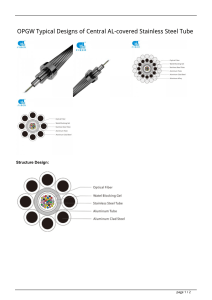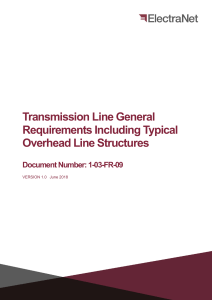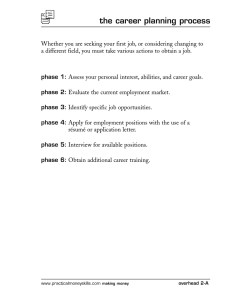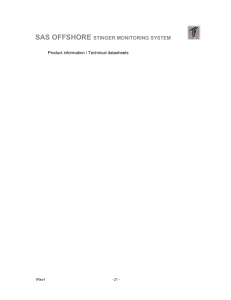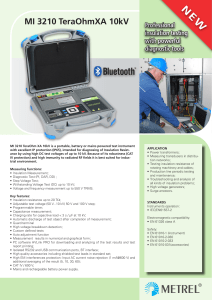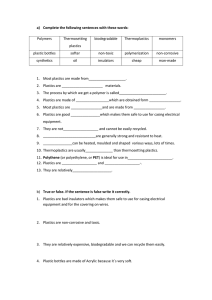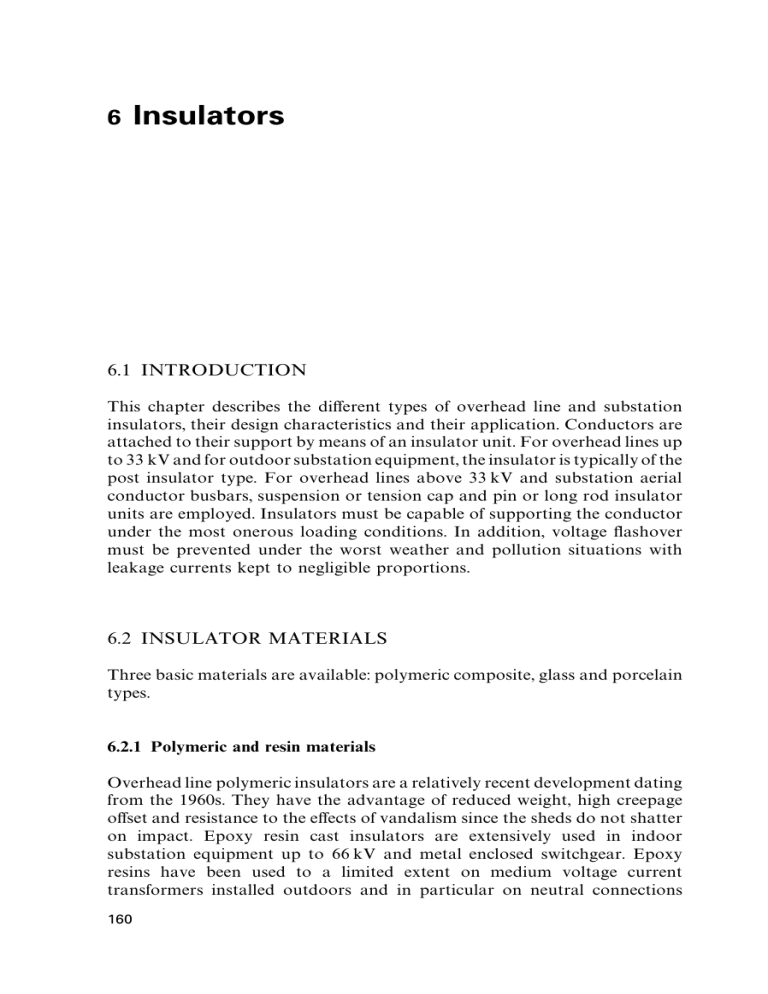
6 Insulators 6.1 INTRODUCTION This chapter describes the different types of overhead line and substation insulators, their design characteristics and their application. Conductors are attached to their support by means of an insulator unit. For overhead lines up to 33 kV and for outdoor substation equipment, the insulator is typically of the post insulator type. For overhead lines above 33 kV and substation aerial conductor busbars, suspension or tension cap and pin or long rod insulator units are employed. Insulators must be capable of supporting the conductor under the most onerous loading conditions. In addition, voltage flashover must be prevented under the worst weather and pollution situations with leakage currents kept to negligible proportions. 6.2 INSULATOR MATERIALS Three basic materials are available: polymeric composite, glass and porcelain types. 6.2.1 Polymeric and resin materials Overhead line polymeric insulators are a relatively recent development dating from the 1960s. They have the advantage of reduced weight, high creepage offset and resistance to the effects of vandalism since the sheds do not shatter on impact. Epoxy resin cast insulators are extensively used in indoor substation equipment up to 66 kV and metal enclosed switchgear. Epoxy resins have been used to a limited extent on medium voltage current transformers installed outdoors and in particular on neutral connections 160 Insulators 161 where the insulation is not subject to the same dielectric stress as the phase conductor supports. Cap and pin insulators used on low voltage distribution lines and long rods at transmission voltage levels may employ composite insulators based on a high tensile strength core of glass fibre and resin. The insulator sheds are bonded to this core and made from silicone and ethylene propylene flexible elastomers. Considerable satisfactory experience under various climatic conditions has now been collected over the last 20 years using these materials. However, there is still some reluctance to specify polymeric insulators for overhead line work because of the conservative nature of the electricity supply industry and doubts about their long-term resistance to ultraviolet exposure and weathering. They have yet to be generally applied to substation installations but have shown good pollution withstand. The advantage of light weight has an overall cost reduction effect on new substation steelwork support structures. 6.2.2 Glass and porcelain Both glass and porcelain are commonly used materials for insulators and have given excellent service history backed by years of manufacturing experience from reputable firms. There is little difference in the cost or performance between glass and porcelain. Toughened glass has the advantage for overhead lines that broken insulators tend to shatter completely upon impact and are therefore more easily spotted during maintenance inspections. In practice, the type to be used on overhead lines will depend partly upon the existing spares holdings and spares rationalization practices employed by the particular electricity supply company. On the other hand, glass insulators are rarely used in substation practice since on shattering they leave only some 15 mm between the top metal cap and the pin. Porcelain insulators, which may be chipped or cracked but not shattered, are therefore preferred for substation use since access for replacement may require a busbar outage. 6.3 INSULATOR TYPES 6.3.1 Post insulators Post insulators comprise of pedestal posts and solid core cylindrical types. Figure 6.1 illustrates the general construction. 6.3.1.1 Pedestal post insulators Pedestal post insulator stacks used in substations are available as single units 162 Insulators Figure 6.1 Solid core cylindrical and pedestal post insulators. (a) Example of an outdoor cylindrical post insulator with external metal fittings. (The example shown is composed of four units, but cylindrical post insulators may consist of one or more units.) (b) Example of an outdoor pedestal post insulator. (The example shown is composed of ten units, but pedestal post insulators may consist of one or more units.) H = height of one unit; D = insulating part diameter with a range of lightning impulse withstand ratings (LIW) from 60 kV to 250 kV per unit. An example of a unit is shown in Fig. 6.2. They have a high bending strength of up to typically 310 kN and in this regard are superior to the solid core types. The units have standardized top and bottom fixing arrangements such that insulator stacks may be built up with bending strengths varying from the maximum required at the base to the minimum at the top. As many as 12 such units may be required to form a post insulator for a 550 kV-rated voltage system. For a given insulator height the total creepage distance is comparable to that of cylindrical posts but a greater protected creepage distance (the distance measured along the underside of the insulator sheds) is feasible and this can be an advantage in certain environments. 6.3.1.2 Solid core cylindrical posts Cylindrical post type insulators are shown in Figs. 6.3a and 6.3b. Shed shapes are usually simplified for ease of production since the units are cast in cylindrical form and machined on vertical milling machines before firing. Insulators 163 Figure 6.2 Pedestal post insulator detail Cylindrical post insulators may also be made up from individual sheds cemented together. This allows more complicated shed profiles to be achieved at the expense of cost and use of special cements to overcome any degradation problems in service. An alternative method of increasing the creepage distance without increasing the overall insulator stack height is shown in Fig. 6.3b. using alternate long short (ALS) insulator shed profiles. These have alternate 164 Insulators Figure 6.3 Cylindrical post insulator detail Insulators 165 sheds of a lesser diameter with the distance between the sheds being of the order of 15 mm. Again standardized top and bottom fixing arrangements allow stacks to be formed from an assembly of single units. Typically one unit may be used for a 72 kV-rated voltage system and up to four units for a 550 kV system. In practice, the number employed is usually determined in conjunction with the insulator manufacturer for a specified bending strength. 6.3.1.3 Hollow insulators Hollow insulators are employed by substation equipment manufacturers to house post type current transformers (CTs), voltage transformers (VTs and CVTs), cable bushings, circuit breaker supports with central operating rods and interrupting chamber assemblies, isolator supports, etc. The specifications are determined between the substation equipment and insulator manufacturers. In particular, the mechanical strength of hollow porcelains must be determined in this way since insulators used in such applications may be subject to sudden pressures such as in circuit breakers or surge arresters. Torsion failing loads are also important where insulators form part of a circuit breaker or isolator drive mechanism. The main issue from the substation designer’s point of view is to adequately specify the required creepage distance (to suit the environmental conditions) and shed shape (to conform with the electricity supply company’s spares holdings or standards). 6.3.2 Cap and pin insulators Cap and pin insulators of porcelain or glass predominate as overhead line suspension or tension sets above 33 kV and they are also used for substation busbar high level strained connections. Almost any creepage distance may be achieved by arranging the required number of individual units in a string. Upper surface shed shapes are similar with the top surface having a smooth hard surface to prevent the accumulation of dirt and moisture and a slope greater than 5° to assist self-cleaning. The under-sides have a considerable variation in shape which depends upon aerodynamic and creepage distance requirements. Fig. 6.4 illustrates standard, anti-fog and aerofoil disc profiles. Suspension insulator sets are rarely used in substation designs and substation busbar tension sets avoid the use of the anti-fog profiles because the deep ribs may not be naturally cleaned by rainfall when mounted nearly horizontally with short spans. Such substation short span applications do not require high strength cap and pin units and the insulators are often specified with 80 kN minimum failing electromechanical failing test load to meet a 3 ; safety factor requirement. Overhead line cap and pin insulators are specified with correspondingly higher failing loads of 125 and 190 kN. 166 Insulators Figure 6.4 Cap and pin insulators 6.3.3 Long rod Long rod insulators are similar to porcelain solid core cylindrical post insulators except that the top and bottom fittings are of the cap and pin type. Long rods are an alternative to the conventional cap and pin insulator sets with the possibility of providing longer creepage paths per unit length. Long rod insulators have not, however, exhibited for overhead line work any marked improvements in performance under heavy pollution conditions. In addition, the mechanical performance of porcelain under tension is such that brittle fracture could easily cause a complete failure of the whole unit leading to an outage condition. In contrast, cap and pin insulators using toughened Insulators 167 Figure 6.5 Long rod insulators glass or porcelain are designed so that they do not exhibit a brittle fracture characteristic. Cap and pin insulators are able to support the full tensile working load with the glass shed shattered or all the porcelain shed broken away. For these reasons cap and pin insulators are more often specified for overhead line work. A selection of long rod porcelain units are shown in Fig. 6.5 and a composite insulator in Fig. 6.6. 6.4 POLLUTION CONTROL 6.4.1 Environment/creepage distances Specific insulator creepage distance is determined for the particular environment 168 Insulators Figure 6.6 Polymeric material insulators. Left: composite insulator; right: epoxy resin distribution line insulator Table 6.1 Relative merits of insulator materials Type Comments Porcelain Good service history. High impact and self-cleaning support. Good service history. Obvious failures may be spotted with glass shattering. Early problems now overcome. Good service history under analysis by electrical supply companies. Advantages for special applications. Glass Polymeric by experience from earlier installations. If no such information is available then for major projects the establishment of an energized test station or overhead line test section one or two years in advance of the insulator material procurement project programme should be established. Various types of insulators and shed profiles may be tested and those with the best performance selected. If insufficient time is available for meaningful testing then the alternative is simply to overinsulate on the basis of results or performance records of insulators used in similar environments elsewhere. A further alternative is to refer to IEC 815 for pollution level descriptions and associated suggested insulator creepage distances. Pollution levels are categorized as shown in Table 6.2. The corresponding minimum nominal specific insulator creepage distances (allowing for manufacturing tolerances) are then selected as shown in Table Insulators 169 6.3. The actual insulator shed profile is also an important factor. For example, the aerofoil profile which does not have ‘skirts’ on the underside (see Fig. 6.4) discourages the adherence of sand and salt spray and has been shown to be successful in desert environments. Some terminology associated with creepage distances and puncture resistance is explained below: Total creepage distance 90° protected creepage Puncture-proof insulators The surface distance over the total upper and lower portions of the insulator surface. The surface distance over the undersurface of the insulator. This is a useful measure for insulators with deep ribs and grooves as used for anti-fog profiles. Those insulators for which all credible surges will flash over the surface of the insulator rather than puncture through the insulator shed material. Ceramic long rod and composite insulators are therefore classed as puncture-proof. Because of their construction cap and pin insulators are classified as non-puncture-proof and such faults, if not accompanied by shed breakage, may be difficult to observe by visual inspection. 6.4.2 Remedial measures In practice, it may be found that insulators in certain existing substations or overhead line sections are causing trouble due to pollution. Remedial measures include: ( Installation of creepage extenders and booster sheds. Increasing the number of insulators in a string has to be carefully considered since if not done at the initial design stage clearances to ground or the supporting structure will be reduced and possibly infringed. ( Use of anti-fog insulator disc profiles (see Fig. 6.4). ( Regular overhead line insulator live line washing using carefully monitored low conductivity water droplet sprays or washing under outage conditions. ( Silicone grease coating of the insulator sheds. The action of the grease is to encapsulate the particles of dirt thus preventing the formation of an electrolyte with moisture from rain or condensation. When the grease becomes saturated with dirt it must be removed and a new coat applied. Greasing is not recommended for use with anti-fog insulator shed profiles. The grease tends to get trapped in the grooves on the underside of the shed and bridged by conductive dirt forming on the grease surface thereby reducing the overall insulator creepage distance. 170 Insulators Table 6.2 Description of polluted conditions for insulator selection Pollution level Examples of typical environments I–Light –Areas without industries and with low density of houses equipped with heating plants. –Areas with low density of industries or houses but subjected to frequent winds and/or rainfalls. –Agricultural areas a –Mountainous areas. All these areas must be situated at least 10 to 20 km from the sea and must not be exposed to winds directly from the sea.b II–Medium –Areas with industries not producing particularly polluting smoke and/or with average density of houses equipped with heating plants. –Areas with high density of houses and/or industries but subjected to frequent clean winds and/or rainfalls. –Areas exposed to wind from the sea but not too close to the coast (at least several kilometres).b III–Heavy –Areas with high density of industries and suburbs of large cities with high density of heating plants producing pollution. –Areas close to the sea or in any case exposed to relatively strong wind from the sea.b IV–Very heavy –Areas generally of moderate extent, subjected to conductive dusts and to industrial smoke producing particularly thick conductive deposits. –Areas generally of moderate extent, very close to the coast and exposed to sea spray or to very strong and polluting winds from the sea. –Desert areas, characterized by no rain for long periods, exposed to strong winds carrying sand and salt, and subjected to regular condensation. Notes:a Use of fertilizers by spraying, or when crop burning has taken place, can lead to higher pollution level due to dispersal by wind. b Distances from sea coast depend on the topography of the coastal area and on the extreme wind conditions. 6.4.3 Calculation of specific creepage path Typical creepage values for either cap and pin insulator strings or post insulators at 132 kV under very heavy pollution, classification IV, would be determined as follows: Nominal voltage Rated voltage Maximum rated voltage Creepage (from Table 6.3) 132 kV rms 145 kV rms phase to phase 31 mm/kV Test creepage distance 145 kV ; 31 mm/kV : 4495 mm Insulators 171 Table 6.3 Guide for selection of insulator creepage distances to suit polluted conditions Pollution level Minimum nominal specific creepage distancea (mm/kV)b I–Light II–Medium III–Heavy IV–Very heavy 16 20 25 31 Notes:a For actual creepage distances the specified manufacturing tolerances are applicable (IEC 273, 305, 433 and 720). b rms value corresponding to the highest voltage for equipment (phase to phase). c In very light polluted areas creepage distances less than 16 mm/kV can be used depending upon service experience. 12mm/kV seems to be a lower limit. d In cases of exceptional pollution a specific nominal creepage distance of 31 mm/kV may not be adequate. Depending upon service experience and/or laboratory test results a higher value of specific creepage distance can be used. From manufacturer’s details: Typical substation insulator Creepage Spacing distance 80 kN minimum failing load 330 mm 127 mm Number of insulators required to provide 4495 mm creepage using cap and pin porcelain string insulators : 4495/330 : 13.6. Therefore the minimum total number of insulators per string would be 14. In this case failure of one unit would reduce the creepage distance to 4165 mm, equivalent to an effective value of 28.7 mm/kV @ 145 kV-rated voltage. However, at the nominal system voltage of 132 kV the design value is maintained at 31.5 mm/kV. Minimum length of suspension insulator string : 14 ; 127 : 1778 mm. Alternatively, 15 insulators per string could be specified in order to maintain the recommended creepage distance at 145 kV-rated voltage under a one insulator shed failure condition. This allows full overhead line operation between normal line maintenance outages at the expense of increased overall string length of 1905 mm. 6.5 INSULATOR SPECIFICATION 6.5.1 Standards Standards are under regular review. Some of the important International Electrotechnical Commission (IEC) insulator standards are listed in Table 6.4. 172 Insulators Figure 6.7 Some typical porcelain insulators (courtesy Allied Doulton) Insulators 173 174 Insulators Figure 6.7 continued Insulators 175 6.5.2 Design characteristics 6.5.2.1 Electrical characteristics The principal electrical characteristics are: ( ( ( ( Power frequency withstand. Lightning impulse withstand voltage—LIWV. Switching impulse withstand voltage—SIWV. Pollution withstand (typically expressed as equivalent salt solution density for the system voltage concerned). ( Radio interference. Note that it is the lightning impulse withstand voltage that appears in manufacturers’ and IEC insulator selection tables to categorize all insulators and not the system-rated voltage U . The switching impulse withstand voltage has more influence on designs above about 300 kV. 6.5.2.2 Mechanical characteristics The principal mechanical characteristics are: ( Tensile strength (string insulators). ( Cantilever strength (rigid insulators). For overhead lines these mechanical ratings are determined by the factor of safety (usually three or greater), the wind span, the weight span, the uplift and the broken wire requirements. 6.5.2.3 Insulator selection Table 6.5 gives characteristics for outdoor pedestal post insulators taken from IEC 273 and allows identification of an insulator for the required service conditions. The creepage distance is derived as shown in Section 6.4.3. The required mechanical strength for a substation post insulator is derived from a calculation of wind force expressed as a cantilever load at the top of the insulator. A factor of safety of 2.5 or 3 times is applied and the insulator selected from the tables with the appropriate minimum bending failing load. 176 Insulators 6.6 TESTS 6.6.1 Sample and routine tests Routine and type tests for substation and overhead line insulators are clearly set out in the relevant IEC standards listed in Table 6.4. Note that it is unusual to call for tests on hollow insulators to be witnessed at the manufacturer’s works in substation construction contract technical specifications. This is because the substation equipment manufacturers and insulator manufacturer have agreed the requirements between themselves; for example, the appropriate torsion failing load where the insulator is to be used in an isolator drive mechanism. Overall visual inspections on final assembly are, however, worthwhile before allowing release of material for shipment. These checks should include dimensional correctness within the permitted tolerances, alignment and any glaze defects. For cap and pin overhead line insulators one suspension and one tension string of each type should be shown to have been tested in accordance with the provisions of IEC 383, 487 and 575 covering: Table 6.4 Some insulator IEC standards IEC standard Short title 120 137 168 and 273 233 305 and 383 372 433 437 438 471 506 507 Dimensions of Ball and Socket Couplings of String Insulators Bushings for AC above 1000 V High Voltage Post Insulators–Tests and Dimensions Hollow Insulators–Tests Cap and Pin Insulators–Characteristics and Tests Locking devices for Ball and Socket Couplings Characteristics of Long Rod Insulators Radio Interference on HV Insulators (Report) Tests and dimensions of HV DC Insulators Dimensions of Clevis and Tongue Couplings Switching Impulse Tests on Insulators above 300 kV Artificial Pollution Tests (Conductivity and Withstand Levels vs Pollution) Thermal–Mechanical Tests on String Insulators Sampling Rules, etc., for Statistical Control of Testing Line Insulators Indoor Post Insulators of Organic Material 1 kV to 300 kV Characteristics of Line Post Insulators Guide for Selection of Insulators vs Polluted Conditions 575 591 660 720 815 Insulators 177 dimensional checks temperature cycle tests radio interference dry withstand impulse tests wet power frequency withstand including any string fittings as may be incorporated in service — for example arc horns and dampers short circuit tests on complete strings with fittings mechanical test to demonstrate failing load puncture test porosity test galvanizing test Table 6.5 Cap and pin overhead line insulator technical particulars and guarantees Description Manufacturer Maximum working load per string (kN) Spacing of units (mm) Maximum elastic limit of fittings (kN) Electromechanical minimum failing load per unit (kN) Electrostatic capacity per unit (pF) Weight per unit (kg) No. units per string Overall creepage path distance per unit (mm) 90° creepage path distance per unit (mm) Length of string (mm) Weight of insulator set complete with all clamps and fittings (kg) Lift of arcing horn over line end unit (mm) Reach of arcing horn from centre line of string (mm) (note these dimensions may require adjustment to suit impulse test requirements) 50 or 60 Hz withstand voltage per string (wet) (kV) (dry) (kV) Minimum 50 to 60 Hz puncture voltage per string (kV) Impulse flashover voltage per string (50%) ( + kV) ( − kV) Impluse withstand voltage per string ( + kV) ( − kV) Type and requirement or manufacturers guarantee 178 Insulators 6.6.2 Technical particulars Technical particulars associated with overhead line cap and pin insulators and fittings will typically be as shown in Table 6.5.
